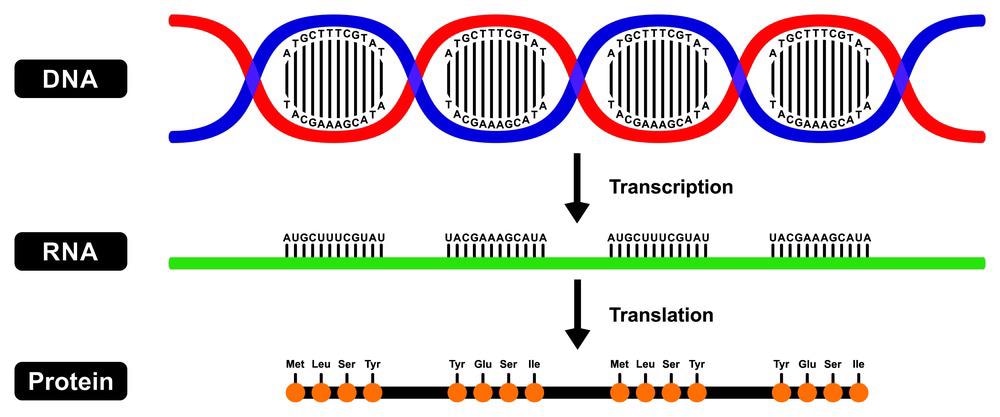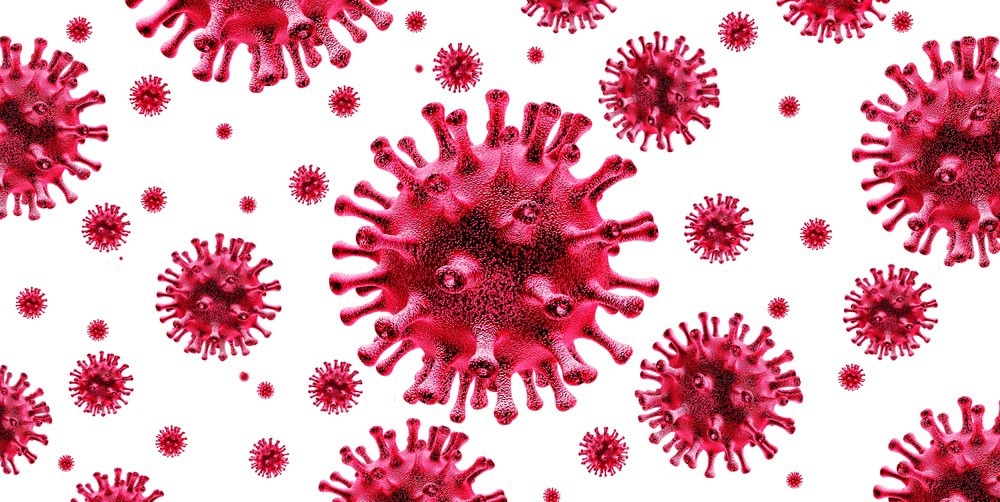The human body contains different types of cells and even though each cell contains the same DNA as a “blueprint”, it synthesizes different types of proteins to carry out specific functions. The process of synthesizing a protein from the genetic information present in DNA is known as the central dogma of molecular biology. Simply put, genetic information flows from DNA to RNA to protein; however, it is not a linear step. In this article, we will be looking at the steps involved in the central dogma as well as exceptions to the process.
From DNA to protein - 3D
Discovering the Central Dogma of Molecular Biology
On 19 September 1957, Francis Crick, as part of the Society for Experimental Biology Symposium on the Biological Replication of Macromolecules, discussed the flow of information between genes and proteins. This symposium was held at the University College London.
In 1956, he wrote a two-page report entitled ‘Ideas on protein synthesis’. The concept of central dogma first surfaced in this document which stated, "Once information has got into a protein it can’t get out again. Information here means the sequence of the amino acid residues, or other sequences related to it." He finally published this hypothesis in 1957.
Gradually, Crick’s concept grew popular in the scientific community and this article started becoming cited more frequently. Interestingly, scientists observed that the pattern of citation is U-shaped, i.e., following publication, the article was cited most in 1962, with a fewer number of citations between the period of 1971 and 1990 and again the citation index peaked in 2014. This indicates that scientists are still interested in the concept of central dogma and much research is being conducted following this hypothesis.
DNA to Protein: The Steps of Central Dogma
The central dogma includes three main steps; transcription, translation, and replication. According to the latest research outcomes, a fourth step that is involved with the RNA processing, or splicing, has been included.
Each human cell consists of double-stranded DNA. A single strand of DNA bears specific sequences of four nucleotide bases, namely, adenine (A), thymine (T), cytosine (C), and guanine (G). These nucleotide bases remain in a complementary pairing such that A pairs with T and C pairs with G. Specific sequences of these nucleotide bases form genes.
A DNA strand comprises millions of nucleotide bases in various combinations to form genes that encode for a specific protein. DNA safely stores the genetic information within the nuclei of cells as a template that is then transcribed to RNA. This process is known as transcription. The steps involved in the production of proteins (the final product) are described below.

Image Credit: udaix/Shutterstock.com
Click here to learn more!
Transcription
As stated above, by the process of transcription, information stored in a DNA strand is copied into a new molecule called messenger RNA (mRNA). Although mRNA carries the same information as DNA, it cannot be used for long-term storage. The site of transcription is the nucleus of a cell.
After the transcription process is complete, mRNA freely exits the nucleus. An mRNA strand is complementary to the DNA template. Several accessory proteins (transcription factors) and RNA polymerase (enzyme) are chiefly responsible for the transcription process.
The main function of the transcription factors is to get attached to specific DNA sequences (enhancer) and promoter sequences. Subsequently, the transcription factors recruit RNA polymerase to a specific transcription site. Transcription factors, as well as RNA polymerase, form a complex called the transcription initiation complex, which initiates transcription.
In this process, the RNA polymerase begins mRNA synthesis using complementary bases of the parent DNA strand. Once the process of elongation of mRNA molecule is over and mRNA strand is completely synthesized, transcription is terminated. This newly synthesized mRNA copy of the gene is used for protein synthesis by the process called translation.
Splicing
In eukaryotic cells, an additional step of splicing takes place. In these cells, the primary transcripts, or pre-mRNA, are processed to form mature mRNA. In this process, the introns or the non-coding sequences present in the pre-mRNA strand are spliced out such that only the exons or the coding sequence remain.
Translation
The process of translation takes place in the ribosomes for eukaryotic organisms. Therefore, the mature mRNA which is produced in the nucleus is transported to the cytoplasm where it attaches to the ribosome and the translation process occurs. The mRNA is read as a triplet codon by the ribosome, with AUG being the start codon (methionine codon), downstream of the ribosome binding site.
The complex formed by the initiation factors and elongation factors recruits aminoacylated transfer RNA (tRNA) into the ribosome-mRNA complex. The tRNA carries the amino acid such that it matches the codon in the mRNA. Specific amino acids are added to the growing chain via peptide bonding; following this, the chain folds in correct conformation. The process of folding continues till the nascent polypeptide chains are released from the ribosome as a mature protein.
Replication
The final step of the central dogma involves transmitting genetic information from parents to progeny. For this, the process of replication is carried out by a complex group of proteins that unwind the double-stranded DNA superhelix. The unwound parental DNA serves as the template for replication. DNA polymerase is the enzyme that carries out the replication process and new strands of identical DNA are produced restoring all the information that was present in the parental DNA strand.
What are the Exceptions to the Central Dogma?
The hypothesis of the central dogma stands true for many prokaryotic and eukaryotic organisms. However, scientists found a contradiction while studying retroviruses. Retroviruses transcribe RNA to DNA via a special enzyme known as reverse transcriptase, which results in an exception to the central dogma as the information flows as RNA → DNA → RNA → protein. Also, some viruses (RNA → proteins), and prions (Protein → Protein) do not follow the central dogma.

Image Credit: Lightspring/Shutterstock.com
Sources:
- The Central Dogma of Biology. London Health Science Center. (2021) [Online] Available at: https://www.lhsc.on.ca/medical-genetics-program-of-southwestern-ontario/the-central-dogma-of-biology
- Central Dogma. Harvard University (2018) [Online] Available at: https://sitn.hms.harvard.edu/art/2018/central-dogma/
- Cobb, M. (2017) 60 years ago, Francis Crick changed the logic of biology. PLoS Biology. 15(9): e2003243. https://doi.org/10.1371/journal.pbio.2003243
- Perkins, D. et al. (2005) Expanding the ‘central dogma’: the regulatory role of nonprotein coding genes and implications for the genetic liability to schizophrenia. Molecular Psychiatry. 10, pp. 69–78 https://doi.org/10.1038/sj.mp.4001577
Further Reading